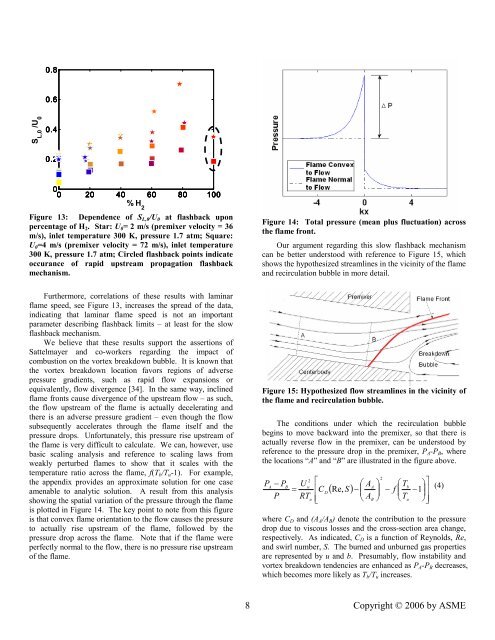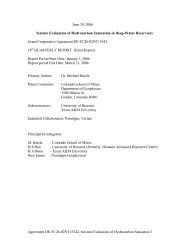Syngas Mixture Composition Effects Upon Flashback and Blowout
Syngas Mixture Composition Effects Upon Flashback and Blowout
Syngas Mixture Composition Effects Upon Flashback and Blowout
You also want an ePaper? Increase the reach of your titles
YUMPU automatically turns print PDFs into web optimized ePapers that Google loves.
0.8<br />
0.6<br />
S L,0<br />
/U 0<br />
0.4<br />
0.2<br />
0<br />
0 20 40 60 80 100<br />
% H 2<br />
Figure 13: Dependence of S L,0 /U 0 at flashback upon<br />
percentage of H 2 . Star: U 0 = 2 m/s (premixer velocity = 36<br />
m/s), inlet temperature 300 K, pressure 1.7 atm; Square:<br />
U 0 =4 m/s (premixer velocity = 72 m/s), inlet temperature<br />
300 K, pressure 1.7 atm; Circled flashback points indicate<br />
occurance of rapid upstream propagation flashback<br />
mechanism.<br />
Figure 14: Total pressure (mean plus fluctuation) across<br />
the flame front.<br />
Our argument regarding this slow flashback mechanism<br />
can be better understood with reference to Figure 15, which<br />
shows the hypothesized streamlines in the vicinity of the flame<br />
<strong>and</strong> recirculation bubble in more detail.<br />
Furthermore, correlations of these results with laminar<br />
flame speed, see Figure 13, increases the spread of the data,<br />
indicating that laminar flame speed is not an important<br />
parameter describing flashback limits – at least for the slow<br />
flashback mechanism.<br />
We believe that these results support the assertions of<br />
Sattelmayer <strong>and</strong> co-workers regarding the impact of<br />
combustion on the vortex breakdown bubble. It is known that<br />
the vortex breakdown location favors regions of adverse<br />
pressure gradients, such as rapid flow expansions or<br />
equivalently, flow divergence [34]. In the same way, inclined<br />
flame fronts cause divergence of the upstream flow – as such,<br />
the flow upstream of the flame is actually decelerating <strong>and</strong><br />
there is an adverse pressure gradient – even though the flow<br />
subsequently accelerates through the flame itself <strong>and</strong> the<br />
pressure drops. Unfortunately, this pressure rise upstream of<br />
the flame is very difficult to calculate. We can, however, use<br />
basic scaling analysis <strong>and</strong> reference to scaling laws from<br />
weakly perturbed flames to show that it scales with the<br />
temperature ratio across the flame, f(T b /T u -1). For example,<br />
the appendix provides an approximate solution for one case<br />
amenable to analytic solution. A result from this analysis<br />
showing the spatial variation of the pressure through the flame<br />
is plotted in Figure 14. The key point to note from this figure<br />
is that convex flame orientation to the flow causes the pressure<br />
to actually rise upstream of the flame, followed by the<br />
pressure drop across the flame. Note that if the flame were<br />
perfectly normal to the flow, there is no pressure rise upstream<br />
of the flame.<br />
Figure 15: Hypothesized flow streamlines in the vicinity of<br />
the flame <strong>and</strong> recirculation bubble.<br />
The conditions under which the recirculation bubble<br />
begins to move backward into the premixer, so that there is<br />
actually reverse flow in the premixer, can be understood by<br />
reference to the pressure drop in the premixer, P A -P B , where<br />
the locations “A” <strong>and</strong> “B” are illustrated in the figure above.<br />
2<br />
2<br />
P ⎡ ⎛ ⎞ ⎛ ⎞⎤<br />
A<br />
− P U<br />
B u<br />
A T<br />
A<br />
b<br />
= ⎢C<br />
( Re, S ) −<br />
⎜<br />
⎟ − f<br />
⎜ −1<br />
⎟<br />
(4)<br />
D<br />
⎥<br />
P RTu<br />
⎢⎣<br />
⎝ AB<br />
⎠ ⎝ Tu<br />
⎠⎥⎦<br />
where C D <strong>and</strong> (A A /A B ) denote the contribution to the pressure<br />
drop due to viscous losses <strong>and</strong> the cross-section area change,<br />
respectively. As indicated, C D is a function of Reynolds, Re,<br />
<strong>and</strong> swirl number, S. The burned <strong>and</strong> unburned gas properties<br />
are represented by u <strong>and</strong> b. Presumably, flow instability <strong>and</strong><br />
vortex breakdown tendencies are enhanced as P A -P B decreases,<br />
which becomes more likely as T b /T u increases.<br />
8<br />
Copyright © 2006 by ASME
















